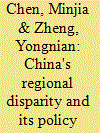| Srl | Item |
| 1 |
ID:
082641


|
|
|
| 2 |
ID:
122367


|
|
|
|
|
| Publication |
2013.
|
| Summary/Abstract |
The interaction within BRICS has drawn a variety of comments - from sarcasm to the expectation of miracles. But the aggravation of problems with the sustainability of global development in 2008-2013 has brought the role of those states into the limelight to show that global decisions will not be necessarily found inside Bretton-Woods institutions or the OECD.
|
|
|
|
|
|
|
|
|
|
|
|
|
|
|
|
| 3 |
ID:
112731


|
|
|
|
|
| Publication |
2012.
|
| Summary/Abstract |
In many countries inward foreign direct investment (FDI) typically concentrates in a few regions. However, there is little empirical evidence on whether spatially concentrated FDI boosts economic growth in other regions within the same country. We use a dataset that covers 96% of Chinese cities from 1996 to 2004 and find that "inter-regional spillovers" from FDI concentrated in China's coastal cities have a positive and significant effect on the growth of inland cities. In addition, an inland city's industrial development affects its absorptive capacity to gain such inter-regional spillovers from coastal FDI.
|
|
|
|
|
|
|
|
|
|
|
|
|
|
|
|
| 4 |
ID:
119210


|
|
|
|
|
| Publication |
2013.
|
| Summary/Abstract |
Foreign direct investments (FDI) are an important determinant of economic growth. Countries try to attract mobile capital in order to foster economic development, albeit FDI might increase regional inequality since the many different regions of a country usually do not receive FDI in equal measure. A conflict emerges between efficiency and redistribution. The aim of this paper is to investigate the impact of foreign direct investment on regional inequalities. First, the Chinese case is analyzed as an introductory example. FDI has increased regional inequalities in China after the economic reforms in the 1980s, but the effect has vanished - if not reversed - since the end of the 1990s. Second, the major contribution of the paper is to analyze cross-country time-series data on FDI and regional inequalities. Based on a unique panel data set of regional inequalities covering 55 countries at different stages of development, I find net FDI inflows to increase regional inequality in low and middle income countries, while there are no negative redistributional consequences in high income economies. The analysis also shows that the observable higher mobility of individuals in highly developed countries as well as government policies are likely to mitigate the negative redistributional impact of FDI on regional inequality. Insofar, the cross-country data supports the lessons from the Chinese case with respect to the reducing effect development has on the negative impact from FDI on regional inequality.
|
|
|
|
|
|
|
|
|
|
|
|
|
|
|
|
| 5 |
ID:
109740


|
|
|
|
|
| Publication |
2011.
|
| Summary/Abstract |
In this article I study regional growth and sub-national income convergence in India in the context of economic reforms that have been undertaken since 1991. I also examine convergence in development inputs such as population growth, literacy and investment at the sub-national level. My results show that there is a strong evidence of divergence in per capita income of the 15 states studied in the sample. The standard deviation of net state domestic product has increased over time indicating no evidence of convergence in the pre- or post-reform period. Population, state capital expenditure and commercial bank credit have also diverged over time across these 15 Indian states. However, literacy shows evidence of convergence across states.
|
|
|
|
|
|
|
|
|
|
|
|
|
|
|
|
| 6 |
ID:
120401


|
|
|
|
|
| Publication |
2013.
|
| Summary/Abstract |
This paper provides a historical overview of China's telecom development since market reform. Using Sichuan and Guangdong Provinces for comparison, the paper delineates two stages of telecom reform and explores how telecom networks foster domestic regional and social inequalities within the general process of development.
|
|
|
|
|
|
|
|
|
|
|
|
|
|
|
|
| 7 |
ID:
143408


|
|
|
|
|
| Summary/Abstract |
Our study documents the recent narrowing of the coast-inland divide in China. We argue that this rebalancing reflects, with a time lag, the catching up process which has been at work in the industry of the inland region since the end of the 1990s. The pattern is in line with the rapid and unconditional convergence observed in China's manufacturing industry over this period. The convergence of labor productivity suggests that advanced coastal regions have transferred capital and technology to the interior.
|
|
|
|
|
|
|
|
|
|
|
|
|
|
|
|